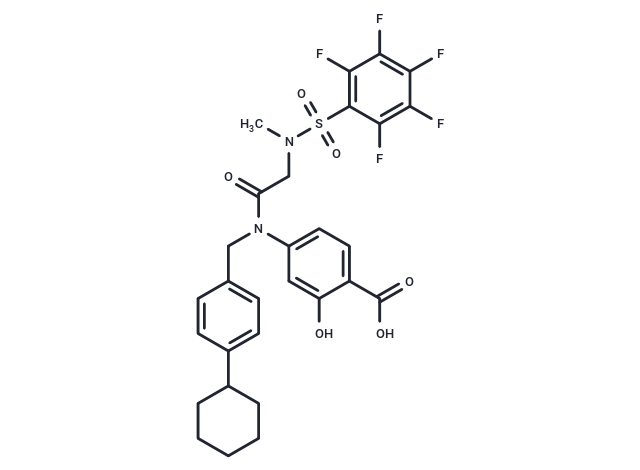Shopping Cart
- Remove All
 Your shopping cart is currently empty
Your shopping cart is currently empty

BP-1-102 is an orally active, effective, and specific STAT3 inhibitor that binds Stat3 (Kd: 504 nM), blocks Stat3-phosphotyrosine (pTyr) peptide interactions and Stat3 activation (4-6.8 μM), and selectively inhibits the migration, survival, growth, and invasion of Stat3-dependent tumor cells. The BP-1-102-mediated inhibition of aberrantly active Stat3 in tumor cells suppresses the expression of [c-Myc, Bcl-xL, Cyclin D1, Survivin, and VEGF].

| Pack Size | Price | Availability | Quantity |
|---|---|---|---|
| 1 mg | $33 | In Stock | |
| 2 mg | $47 | In Stock | |
| 5 mg | $76 | In Stock | |
| 10 mg | $122 | In Stock | |
| 25 mg | $222 | In Stock | |
| 50 mg | $372 | In Stock | |
| 100 mg | $549 | In Stock | |
| 1 mL x 10 mM (in DMSO) | $106 | In Stock |
| Description | BP-1-102 is an orally active, effective, and specific STAT3 inhibitor that binds Stat3 (Kd: 504 nM), blocks Stat3-phosphotyrosine (pTyr) peptide interactions and Stat3 activation (4-6.8 μM), and selectively inhibits the migration, survival, growth, and invasion of Stat3-dependent tumor cells. The BP-1-102-mediated inhibition of aberrantly active Stat3 in tumor cells suppresses the expression of [c-Myc, Bcl-xL, Cyclin D1, Survivin, and VEGF]. |
| Targets&IC50 | STAT3:504 nM(Kd) |
| In vitro | BP-1-102 binds Stat3 with an affinity (KD) of 504 nM, inhibits Stat3-phospho-tyrosine (pTyr) peptide interactions and Stat3 activation at 4-6.8 μM, and selectively inhibits the growth, survival, migration, and invasion of Stat3-dependent tumor cells. BP-1-102-mediated inhibition of aberrant Stat3 in tumor cells suppresses the expression of c-Myc, Cyclin D1, Bcl-xL, Survivin, VEGF, and Krüppel-like factor 8, a Stat3 target gene promoting breast tumor cell migration and invasion. Treatment of breast cancer cells with BP-1-102 also blocks Stat3–NF-κB cross-talk, the release of several cytokines, and the phosphorylation of focal adhesion kinase and paxillin, while enhancing E-cadherin expression. BP-1-102 inhibits Stat3 DNA-binding activity in vitro with an IC50 of 6.8±0.8 μM and preferentially inhibits Stat3-Stat3 over other Stat dimer DNA-binding activities. BP-1-102 exerts minimal or no effect on phospho-Shc, Src, Jak-1/2, Erk1/2, or Akt levels[1]. |
| In vivo | Intravenous or oral gavage delivery of BP-1-102 furnishes micromolar or microgram levels in tumor tissues and inhibits growth of human breast and lung tumor xenografts and modulates Stat3 activity, Stat3 target genes, and soluble factors in vivo. BP-1-102 selectively suppresses growth, survival, malignant transformation, migration, and invasion of malignant cells harboring constitutively active stat3. BP-1-102 is detectable at micromolar concentrations in plasma and in micrograms in tumor tissues[1]. |
| Kinase Assay | Kinase targets are tested with biochemical enzymatic kinase assays using the SelectScreen Kinase Profiling Service to determine IC50 values. The compounds (XMD8-87) are assayed at 10 concentrations (3-fold serial dilutions starting from 1 μM) at an ATP concentration equal to the ATP Km[1]. |
| Cell Research | Proliferating cells in 6- or 96-well plates are treated once with 0–30 μM BP-1-102 for 24 h or with 10 μM BP-1-102 for up to 96 h. Viable cells are counted by trypan blue exclusion/phase-contrast microscopy or assessed by a CyQUANT Cell Proliferation Kit.(Only for Reference) |
| Molecular Weight | 626.59 |
| Formula | C29H27F5N2O6S |
| Cas No. | 1334493-07-0 |
| Smiles | CN(CC(=O)N(Cc1ccc(cc1)C1CCCCC1)c1ccc(C(O)=O)c(O)c1)S(=O)(=O)c1c(F)c(F)c(F)c(F)c1F |
| Relative Density. | 1.474 g/cm3 (Predicted) |
| Storage | Powder: -20°C for 3 years | In solvent: -80°C for 1 year | Shipping with blue ice. | |||||||||||||||||||||||||||||||||||
| Solubility Information | Ethanol: < 1 mg/mL (insoluble or slightly soluble) DMSO: 93 mg/mL (148.42 mM), Sonication is recommended. H2O: < 1 mg/mL (insoluble or slightly soluble) | |||||||||||||||||||||||||||||||||||
Solution Preparation Table | ||||||||||||||||||||||||||||||||||||
DMSO
| ||||||||||||||||||||||||||||||||||||

Copyright © 2015-2025 TargetMol Chemicals Inc. All Rights Reserved.